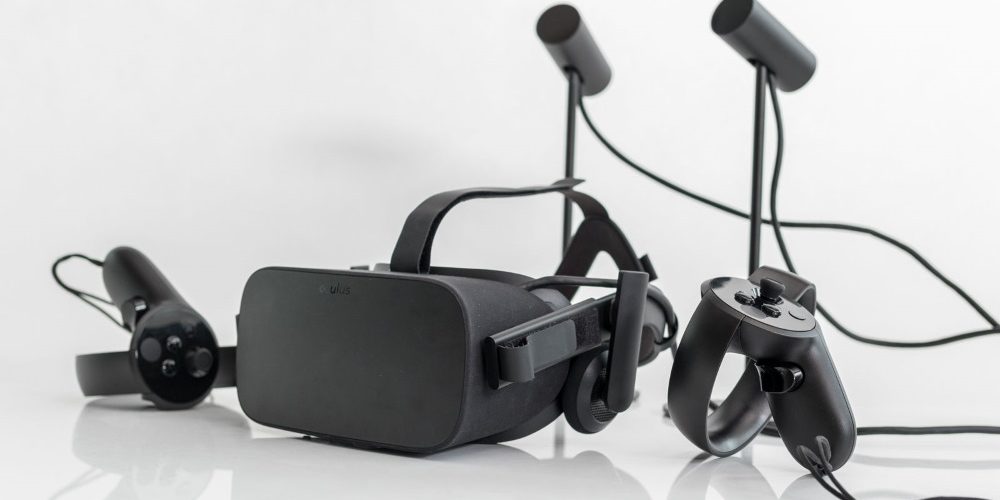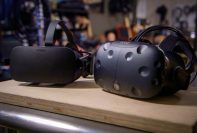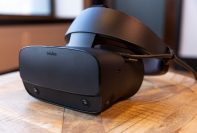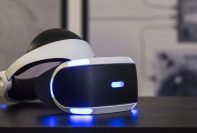The PC-tethered VR headset war is clearly getting more intense.
The two competitors – HTC and Oculus – are upgrading their VR headsets and other accessories to impress the audience and to gain a larger market share.
We already have three top-tier VR headsets.
HTC is ready to launch another one in the market, while Oculus has already announced the Oculus Rift S, which has impressed many people.
As a result, it can be difficult for a newcomer to get a clear idea of where he or she should start.
The first thing that we would recommend you is to for you to select either the Oculus Rift or the HTC Vive.
This is because of both of them – once the kings in the industry – have now become entry-level headsets.
They won’t cost as much as the upcoming VR headsets by companies, like Sony, HTC, and Oculus.
This will allow you to test the waters, to see if you really love the VR scene.
You will have fewer regrets knowing that you didn’t waste even more money on VR headsets, by buying the latest gear if you didn’t like virtual reality.
Our job is to keep you updated on everything that’s happening in the industry and to paint a clear picture to learn from.
Since virtual reality is not a very common and widely adopted technology, few people know how to evaluate VR headsets.
This is especially true for the newcomers who have heard about VR is and are excited about it.
If you one of those people, this review will provide useful information about the Oculus Rift, so that you can make an educated decision on the best VR headset for you.
It is important for you to choose wisely because time and money must be invested in virtual reality.
If you ended up not liking your experience, you would regret spending all that time and money.
Let’s begin!
Release Date and Price
The global launch of the Oculus Rift occurred on March 28, 2016.
Similar to other PC-tethered VR headsets at that time, it failed to gain traction.
It was not because something was wrong with it.
The problem was that Oculus and HTC both rushed into an immature market and introduced very expensive products that people were not yet ready to adopt.
However, the Oculus Rift eventually started gaining some success, as interest grew in virtual reality and cost of the top-tier VR headsets started to decline.
Oculus has been very aggressive in the market with its Rift headset.
Oculus’ drastic price cuts even forced HTC to drop the price of their Vive to close the price difference between the Oculus Rift and the HTC Vive.
The Oculus Rift was initially launched with a price tag of $500.
Its price increased to approximately $625, just two months after its launch.
However, Oculus determined that with this price tag, the Rift would never be successful.
The price was among the major factors that were keeping people from buying a VR headset.
Oculus immediately shifted its strategy and started heavily cutting the price of the Oculus Rift.
After a few major price cuts, the Oculus Rift is now available for $440, which is a sweet spot.
Oculus has been sold for as low as $249 during special sales such as on Black Friday and Christmas.
Since the Oculus Rift by itself will cost between $250 and $400, it is necessary to discuss the price of the gaming computer necessary for powering up the VR headset.
Many people getting started with VR, don’t think about this.
As a result, they end up regretting their decision to buy a VR headset, without accounting for the gaming PC budget.
We will describe everything that you need to get started on the Oculus Rift, along with the price of those components.
This will give you a clear idea of how much you will have to spend if you don’t have a gaming computer.
It is important to understand that virtual reality is very graphics-intensive and only the relatively high-end configurations are able to handle it.
Oculus Rift’s minimum specifications call for a relatively cheaper computer.
However, the minimum-spec PC will only be able to run at 45 frames per second.
45 frames per second are very slow, which we will discuss that reason later.
The 90 Hz refresh rate and frames per second is your go-to mark, which is why we will only discuss the recommended specs.
Oculus recommends that you have a computer with the following configuration:
- Processor: Intel i5 4590 / AMD Ryzen 5 1500X or better
- Graphics Card: NVIDIA GeForce GTX 1060 / AMD Radeon RX480 or better
- RAM: More than 8 GB of RAM (16 GB would be optimal)
- Operating System: Windows 10
- Serial Connectivity: 3 USB 3.0 ports and 1 USB 2.0 port
- Video Connectivity: HDMI 1.3 port
A gaming computer configured for the list provided above would cost between $800 and $1,500, depending on the variant you are buying and whether there are any discounts.
A pre-built system or a laptop with similar specs would cost at least $1,100 to $1,300.
Oculus recommends the same configurations for its latest Oculus Rift S headset.
This computer would be compatible if you decide to upgrade to the Oculus Rift in the future.
If you combine the price of the VR headset with the mean price of the starting gaming computer, it would require a total budget of between $1,149 and $1,849.
That is the total investment required, instead of just $349.
If you have a gaming computer that is powerful enough to run the Rift, you won’t have to worry about the cost of a gaming computer.
If you have a gaming computer but it needs minor upgrades, then you also will be able to save a lot of money.
Design
You now know what the Oculus Rift will cost you.
We next discuss the design traits of the Oculus Rift to see if it is the right fit for you.
The design of a VR headset plays a major role in the usability of the device.
You can only play VR games if you don’t feel tired, sick, or irritated.
If the design of a VR headset is done right, you can use it for hours at a time.
Is Oculus Rift’s design worth it? Let’s find out!
Extremely Comfortable Material and Dimensions
If you have asked how comfortable the Oculus Rift is, you probably know what we are going to say next.
The Oculus Rift is one of the most comfortable VR headsets that is available.
The overall look of the headset is non-threatening.
It is a soft, fluffy and carefully designed piece of hardware that will not irritate your skin, nose, forehead or your neck.
The whole exterior of the headset is wrapped with a rugged black fabric, which is soft to the touch.
The exterior is very inviting. It will make you want to put it on and start gaming.
The interior material is also very soft and cushiony.
It doesn’t irritate the forehead much either.
The nasal guard is placed firmly and the material itself is soft enough to keep your nasal bridge comfortable.
However, it is not so much that it gets torn over time.
Lightweight and Very Balanced
The Oculus Rift is a relatively lightweight device compared to its competitors.
This makes it easy for the strap to distribute the weight across your head, with a very small amount of pressure applied to your forehead and nasal bridge.
You will eventually get used to the weight of the headset and will be able to use it for hours at a time.
The lightweight design of the Oculus Rift also works great at keeping the strain off your neck.
Superbly Designed Controllers
The Oculus Touch Controllers are among the most comfortable controllers available.
Oculus has clearly given considerable thought to the design of the controllers. the result is absolutely amazing.
The design of the handle, weight distribution and the placement of triggers and buttons may cause you to forget that you’re holding anything at all.
We loved it during our testing.
We found that we could even perform better with them, compared to other controllers (such as the ones that come with Sony’s PSVR).
Mechanical IPD Adjustment System
The interpupillary distance (IPD) is the distance between the pupil of your eye and the display lens.
Based on your eyesight, this distance will change the clarity of the image you see.
You just slide a knob on the lower right side of the Oculus Rift, until the display becomes crystal clear.
You are then good to go.
The IPD adjustment system is a great alternative for people who wear eyeglasses.
You won’t have to wear them when in VR.
All you have to do is adjust the IPD so that it displays perfectly to your eye.
Mechanical implementation of IPD adjustment means that the distance can be pushed to both the extreme ends, before reaching its limit.
Since the distance is physically adjusted, your brain won’t be getting fooled.
Software-based IPD adjustment changes the rendering configuration of the image so that it emulates the results of the mechanical IPD adjustment.
This implementation not only has a smaller range than its mechanical alternative but it sometimes also gets recognizable, which ruins the player’s mood.
Cap-Style Head Straps
One thing that Oculus did absolutely right in the Oculus Rift, is its baseball cap-style head strap.
There is no Velcro to deal with, no knobs to turn and no straps to tighten.
All that you need to do is to put the rear end of the headset on the back of your head and pull the headset down towards your face.
By contrast, most VR headsets require you to set the visor on your face and then put on the strap and adjust it.
This has made our lives much easier.
This is because when in VR, you will frequently have to take off the VR headset and do something.
Your friend might be calling you, you might want to drink a glass of water, you might need to talk to someone or your phone could be ringing.
Whatever the reason, you will often have to take off your VR headset.
You can, therefore, imagine how hard a Velcro strap like the one in the HTC Vive could get.
However, this is not the case with the Rift.
With the Rift, it was as simple as taking off and putting on a baseball cap.
Everyone who tries the Oculus Rift loves this feature.
Hard to Put on and Take Off with Eyeglasses
We have mentioned that the Oculus has a very helpful baseball-cap style system to put on and take off.
Unfortunately, this system can become a nightmare, if you try to put on or take off the headset with eyeglasses on.
There is ample space inside the headset for you to wear any average-sized frame, but the ease factor will be nullified.
You must be very careful and use dexterity to properly put on the headset without upsetting your eyeglasses.
However, since the Oculus Rift has a mechanical IPD adjustment system, we don’t recommend that you use your eyeglasses.
If you still want to use them, be very careful while putting on the headset or taking it off.
This is is because it could put considerable pressure on your eyeglasses if you slide the headset down like a baseball cap, which could be uncomfortable on your nasal bridge.
Not Too Great Built-in Speakers
While it is good that the Oculus Rift comes with a built-in speaker on the head strap, we think that it could have been better without much additional cost.
The speakers work great below 70% volume.
However, above that level, you can clearly hear the sound crackling.
Since the VR experience should fool you into feeling a new reality, a crackling sound is the last thing you want to hear during your VR gaming sessions.
If the speakers work well below 70% volume, how about keeping it there?
That’s also not the best option either.
Since these speakers aren’t earbuds or headphones that form a seal around your ear, noises from your environment will easily enter your ear.
That case is as bad for your immersion, like the crackling sound itself.
This created a dilemma where neither options worked for us.
We eventually had to get our own HQ earphones.
However, to our disappointment, the Oculus Rift does not have an auxiliary headphone jack.
It was an unnecessarily long process to set up your own earphones for the Oculus Rift, but it had to be done.
Uncomfortable Routing of a Comfortable Cable
The main cable that connects the Oculus Rift to the gaming computer consists of two connectors that are sleeved in a single cable.
This style makes the cable very easy to handle and less fussy.
However, the routing of that cable on the head strap was very inconvenient.
The tethering cable is routed along the strap on the left.
The problem is that the cable eventually gets clear from the headset.
However, not before it rests annoyingly on the user’s shoulder.
It’s a very mild but very annoying feeling.
It is like something is brushing off your shoulder.
During our testing, we kept jerking it off our left shoulders because it was distracting enough.
Our best recommendation would be to reroute it somehow, so that it goes through the back of your neck, like the HTC Vive’s cable does.
Performance
Before you make your decision, it is very important for you to know about the specifications and performance of the Oculus Rift, so that you can know what to expect.
Screen Resolution and Refresh Rate
The Oculus Rift’s display has a display resolution of 2,400 x 1,080 (or 1,200 x 1,080 per eye), with a refresh rate of 90 Hz.
While this resolution isn’t that high, it is still is pretty indistinguishable, if you compare it to the display resolution of the Sony PSVR and the HTC Vive.
You will see a very clear difference once you compare the display resolution of the HTC Vive Pro with the Oculus Rift.
However, the price difference between the two VR headsets is too great that you can’t compare them with each other.
The most important part is the refresh rate.
Most of the VR headsets offer a refresh rate of 90 Hz, which is the only acceptable rate in our opinion.
With lower refresh rates, we have experienced serious problems, such as headaches, nausea, motion sickness, and panic.
The Oculus Rift delivers perfectly in this case, with a 90 Hz refresh rate.
Tracking
The Oculus Rift has an amazing tracking system, which feels almost seamless and highly accurate as long as it works.
There is a small problem with the motion tracking of the Oculus Rift.
At some point during your gaming session, you will be stuck wherever you are, no matter how much you move around physically.
That is the Oculus Rift recalibrating its tracking sensors because it just failed to do the job properly.
This has been a common problem in the Oculus Rift’s controllers, as well as in the room-scale tracking sensors that the Oculus Rift comes with.
It is possible to buy another sensor to make the room-scale tracking flawless.
It also greatly improves the tracking performance of the controllers.
However, we still think that a $1,500 investment is too much to get into VR.
Therefore, spending another $100 to improve the tracking, would be a mood killer for many people.
As long as you don’t have the third sensor, it will be annoying.
You will feel that your character is performing the actions you perform physically in an inaccurate manner.
This feeling will continue to intensify until the system stops tracking altogether.
When this happens, you will have to wait for a second or two before it returns to normal function.
Oculus Rift VR Gaming Setup
Oculus Rift’s setup process is very easy and simple.
We have mentioned previously that the HTC Vive requires extra steps to set up.
However, the Oculus Rift’s setup is extremely easy with no technical knowledge required.
You can download the setup software from Oculus’ official website and run it right away.
The setup will automatically fulfill all of the dependencies and install all of the necessary drivers.
You don’t need to set up a duplicate display, like in the Sony PSVR’s setup.
It is also not necessary to worry about compatibility or drivers, like in the HTC Vive’s setup.
Start by plugging tin he audio and an HDMI cable from the tethering cable.
The next step is to connect the sensors to the available USB 2 or USB 3 ports.
We recommend that you use the available USB 3 ports for your sensors.
All of the other hardware would work fine with USB 2 ports.
Since the tracking sensors have to send the data to the system in real-time, USB 3 ports work best for them.
Once you’ve done it, the software will show the number of tracking sensors it has detected.
That’s all you need to do for closed-space VR.
For room-scale, you will have to do some work to readjust the tracking sensors, so that they are at the most optimal positions.
However, once that step is completed, the rest of the setup shouldn’t take more than 10 minutes to install all the drivers and so you can get started.
Once the setup is done, put on your VR headset and hold the controllers.
You will be taken to a futuristic environment, where the system will get you acquainted with the user interface.
It will also help you to understand the functions of the different buttons and triggers on the Oculus Touch controllers.
After that is done, you can start downloading games and begin to play.
Game Library
There was a time when it could be said that the HTC Vive has a far better content library than the Oculus Rift.
However, those times are gone.
Both companies have rallied creative and talented VR developers, who have created exquisite content for both platforms.
They are currently working on even more amazing VR content for you.
The content library of any product is extremely important for the success of a VR headset.
Why would anyone buy it, if there isn’t enough content for the user to play?
Fortunately, Oculus knows this.
They have an amazingly large and versatile collection of VR games and apps that will astound you in many different ways.
There are a number of VR games, like Robo Recall by Epic Games, that fully use the functionality of the Oculus Touch controllers in a very creative way.
In Robo Recall, you can interact with the environment by holding robots up in the air as a shield, literally catch bullets and throwing them back to your enemy, or if you like, you could get up close and personal and tear the limbs off of your robotic enemies.
There are also super interactive games like Keep Talking and Nobody Explodes, that you can play with your friends.
In this game, one player is wearing the VR headset and the others have a manual about different bomb types and instructions to defuse those bombs.
The player with the headset will have to describe the bomb to his friends, who will then blindly instruct him on the steps that need to be taken to defuse the bomb.
It is a very fun experience. We had a lot of laughs when playing it.
There are fast-paced action games, like SuperHot VR and EVE Valkyrie, that will pump adrenaline to your brain faster than you would expect.
In SuperHot VR, you can freeze physically, which will result in the whole game freezing itself.
You can then evaluate your scenario, make a perfect plan to dodge the bullets and turn your enemies’ strengths against them.
Execute your plan with perfection and you will get a rush like never before.
What’s even better?
Well, at the end of each level, you can watch a replay of the whole level.
However, in this reply, your character won’t stop and freeze time.
It will feel like you did all of those super cool badass actions, without stopping for even a single second.
We have to admit, it felt pretty heroic to us.
Comparisons
We have discussed most of the significant details of the Oculus Rift in this article.
We will see how it competes with its direct rival sitting in the same price range: the HTC Vive.
Oculus Rift vs HTC Vive
The Oculus Rift and the HTC Vive have gotten pretty close since considerable time and effort has been invested in both of these headsets.
The Oculus Rift has some perks since it comes with built-in speakers.
By contrast, you have to buy a separate head strap that comes with built-in speakers for the HTC Vive.
The Oculus Rift is much lighter and has an extremely ergonomic controller design, while the HTC Vive’s controllers don’t.
The HTC Vive also does better than the Oculus Rift in other aspects.
For instance, the HTC Vive has a crisper display resolution and far better tracking out of the box, compared to the Oculus Rift’s tracking out of the box.
However, in the end, it is a trade-off.
Would you be willing to buy another sensor for the Oculus Rift and play with an indistinguishably lower display resolution (compared to the display resolution of the HTC Vive) and get a better value per dollar?
If yes, the Oculus Rift is your winner.
Our Verdict
Like most decisions in the electronics industry, whether or not you should buy the Oculus Rift isn’t a very simple question to answer.
We will, therefore, present the information and let you decide what works best for you.
The Oculus Rift is a slightly less powerful and less crisp VR headset than the HTC Vive.
However, it is must cheaper than its competitor.
Since it needs a lower-spec gaming computer to run, the cost to buy the gaming computer is also lower in the case of the Oculus Rift.
You will have to compromise a little and buy the third tracking sensor and a nice set of earphones.
However, in the end, you will get the best value in the market at a negligible sacrifice.
However, if you prefer the greater number and you don’t care that much about money, you would be better off with an HTC Vive or even an HTC Vive Pro.




